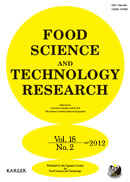Volume 18, Issue 2
Displaying 1-25 of 25 articles from this issue
- |<
- <
- 1
- >
- >|
Food Technology and Engineering
Original papers
-
2012 Volume 18 Issue 2 Pages 131-142
Published: 2012
Released on J-STAGE: June 27, 2012
Download PDF (271K) -
2012 Volume 18 Issue 2 Pages 143-148
Published: 2012
Released on J-STAGE: June 27, 2012
Download PDF (313K) -
2012 Volume 18 Issue 2 Pages 149-156
Published: 2012
Released on J-STAGE: June 27, 2012
Download PDF (669K) -
2012 Volume 18 Issue 2 Pages 157-166
Published: 2012
Released on J-STAGE: June 27, 2012
Download PDF (912K)
Notes
-
2012 Volume 18 Issue 2 Pages 167-171
Published: 2012
Released on J-STAGE: June 27, 2012
Download PDF (533K) -
2012 Volume 18 Issue 2 Pages 173-176
Published: 2012
Released on J-STAGE: June 27, 2012
Download PDF (463K) -
2012 Volume 18 Issue 2 Pages 177-181
Published: 2012
Released on J-STAGE: June 27, 2012
Download PDF (592K) -
2012 Volume 18 Issue 2 Pages 183-186
Published: 2012
Released on J-STAGE: June 27, 2012
Download PDF (404K)
Food Science and Chemistry
Original papers
-
2012 Volume 18 Issue 2 Pages 187-193
Published: 2012
Released on J-STAGE: June 27, 2012
Download PDF (558K) -
2012 Volume 18 Issue 2 Pages 195-199
Published: 2012
Released on J-STAGE: June 27, 2012
Download PDF (244K) -
Effect of Cap Management Technique on the Concentration of Proanthocyanidins in Muscat Bailey A Wine2012 Volume 18 Issue 2 Pages 201-207
Published: 2012
Released on J-STAGE: June 27, 2012
Download PDF (600K) -
2012 Volume 18 Issue 2 Pages 209-217
Published: 2012
Released on J-STAGE: June 27, 2012
Download PDF (1073K) -
2012 Volume 18 Issue 2 Pages 219-226
Published: 2012
Released on J-STAGE: June 27, 2012
Download PDF (395K) -
2012 Volume 18 Issue 2 Pages 227-233
Published: 2012
Released on J-STAGE: June 27, 2012
Download PDF (380K) -
2012 Volume 18 Issue 2 Pages 235-242
Published: 2012
Released on J-STAGE: June 27, 2012
Download PDF (765K) -
2012 Volume 18 Issue 2 Pages 243-250
Published: 2012
Released on J-STAGE: June 27, 2012
Download PDF (341K) -
2012 Volume 18 Issue 2 Pages 251-257
Published: 2012
Released on J-STAGE: June 27, 2012
Download PDF (386K) -
2012 Volume 18 Issue 2 Pages 259-262
Published: 2012
Released on J-STAGE: June 27, 2012
Download PDF (611K) -
2012 Volume 18 Issue 2 Pages 263-269
Published: 2012
Released on J-STAGE: June 27, 2012
Download PDF (671K) -
2012 Volume 18 Issue 2 Pages 271-278
Published: 2012
Released on J-STAGE: June 27, 2012
Download PDF (523K) -
2012 Volume 18 Issue 2 Pages 279-286
Published: 2012
Released on J-STAGE: December 04, 2012
Download PDF (267K) -
2012 Volume 18 Issue 2 Pages 287-294
Published: 2012
Released on J-STAGE: December 04, 2012
Download PDF (947K) -
2012 Volume 18 Issue 2 Pages 295-302
Published: 2012
Released on J-STAGE: December 04, 2012
Download PDF (616K)
Technical paper
-
2012 Volume 18 Issue 2 Pages 303-308
Published: 2012
Released on J-STAGE: December 04, 2012
Download PDF (595K)
Note
-
2012 Volume 18 Issue 2 Pages 309-313
Published: 2012
Released on J-STAGE: December 04, 2012
Download PDF (671K)
- |<
- <
- 1
- >
- >|
